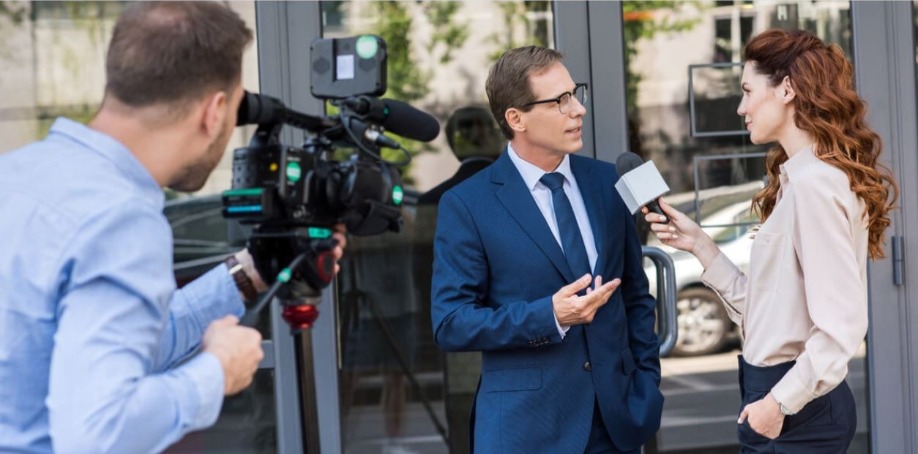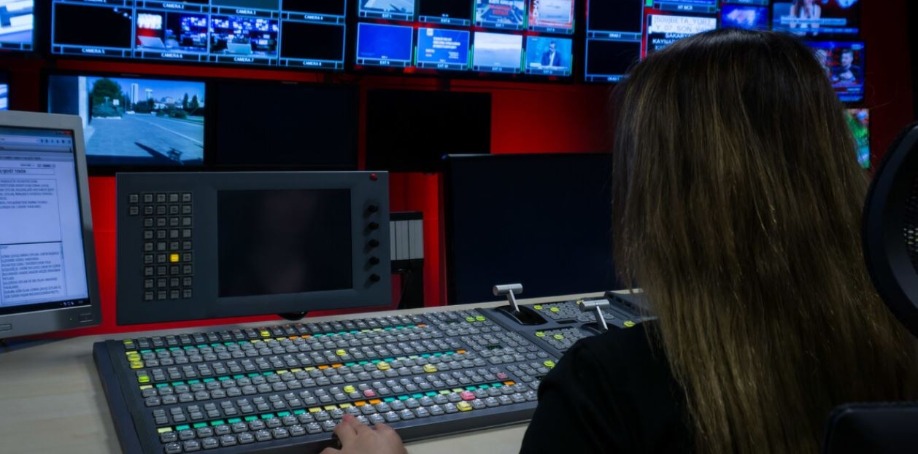
Multiple cameras capture the action. All the data goes to one editing suite packed tight with editors and producers. How can you support that team with the best technology available?
For many, the answer involves AV over IP.
This technology splits big files into small packets that zoom up cables to the editing bay. That allows for quick decisions on the fly, with great raw material to work with. And a system like this scales, so it's easy to add or remove cameras before the next broadcast.
Let's dig into how a few different types of organizations use this technology in their production studios.
Newsrooms Using AV Over IP
Life in a newsroom moves fast. And according to Laura Hazard Owen, deputy editor at Neiman Lab, traditional news cycles are shortening. Even big events that should persist over several days can fade quicker. That means news teams must be agile. When breaking news hits, the editing team has to be ready to process new content.
In an AV over IP environment, the team can pivot to a new camera and a new feed without adding new equipment. And that technology could allow for innovative reporting.
For example, the team at Survive Your Job in Television News says, “Live shots are a great part of television news when done correctly and in a way that has impact. That means showcasing an active scene, being at a scene because new information is imminent, or being able to walk through the remnants of a scene and visually showcase what happened.”
A crew using this method won't stand still in front of a building; they'll be actively reporting, and that feed will head back to the editing bay.
When that feed comes to the control room, the team must think fast. Should this push out live, or should the team delay the action and edit first? Since AV over IP feeds are rich with data, they're relatively easy to edit. And settings can be quickly adjusted to allow for a live transmission or a delayed release.
While AV over IP is applicable to many types of businesses, D. Craig MacCormack at Commercial Integrator Magazine, says television studios and post-editing suites represent a prime area for this technology.
AV Over IP Enters the Classroom
To prepare for jobs in journalism and entertainment, students must practice on modern equipment. And colleges and universities are under pressure to deliver the best experience to recruit top students. For some institutions, that means investing in AV over IP.
Montclair State is one such organization. Plans for a new School of Communication and Media had AV over IP at the center, says Kevin Henneman, president of KMH Integration. School officials considered the technology part of making the new center "future proof" and valuable to scores of students.
With AV over IP technology, colleges and universities could craft news programs with student editors at the helm in editing bays. Institutions could also film musical performances and plays to share with donors and alumni.
Scott Reinhard is the director of broadcast technology for Notre Dame Studios. The school underwent a major technology overhaul and added AV over IP capabilities. "The rate at which the technology changes just keeps getting faster. But now that we're a year out of opening, we're starting to think about what we can really do, like connecting satellite campuses in Ireland, Rome, London, and Beijing," he said in 2018. "What IP routing can let you do changes everything."

Applications in Churches
We might not immediately think of houses of worship as hotbeds of technology. But for many institutions, it's critical to share the message via well-curated video.
DJ Chuang, church strategy consultant, says some churches share video to connect seniors who can't show up to services in person. Others create video to connect with regular parishioners who travel often.
A sophisticated AV over IP system could allow for multi-camera content curation, so viewers could see both the speaker and the audience. Pushing the feed to the editing booth could allow for the right mix of images to inspire and delight those remote viewers.
Some churches also use video to share a service happening at one location with another location. That could have big benefits. "Multisite churches that do not use video teaching are less likely to scale beyond two or three locations. It gets difficult to build a deep bench of good teachers to sustain that model. A church without video and five campuses will need seven pastors teaching 40 weekends a year. That's a huge financial and leadership investment," says Tony Morgan, founder of the Unstuck Group.
Smaller churches may not have several locations and thousands of worshippers. But they may still benefit from advanced technology, especially if it comes with easy-to-follow instructions. Kirk O'Connor, had a system like this when he was using Renewed Vision audio-visual, as lighting director at an Orlando church. "Despite its powerful processing engine and features, it's so user-friendly that I can have new volunteers trained to run it very quickly,'" he said.
Sports Embraces AV Over IP
Just as a newsroom might have dozens of cameras to capture the action, so might a sports stadium. AV over IP could allow the editing booth to pick and choose from multiple angles to find the right shot.
There are plenty of images to choose from. A report from CBS News says, for example, that editors working within the Cowboys' Stadium for the Superbowl have dozens of screens of input to use as they work on the broadcast.
A decision made in the editing booth can become an image on a screen in seconds. Or it could be used in an innovative way to help people have more fun in the stadium.
Ben Dolinky, video engineer at the Mercedes-Benz Stadium in Atlanta, uses video on screens scattered throughout the stadium. "People are expecting to be able to see and hear the game if they're in line or not inside the seating bowl. We really try to listen to what they're wanting us to do and respond to that," he says.

Other Applications for the Technology
Consumers look for opportunities to connect with the people and organizations they love in real time. That means many groups could benefit from a robust capture and editing system.
This shift to live video isn't new. Susan Swain, president and co-CEO of C-Span, talked to the New York Times about the role video played when her company was new. "The fact that people could actually see their elected representatives in their living room—and now on their phones—was a fundamental change," she says. Now, it's become commonplace to require that access.
Some companies adjust by sharing live video without any editing at all. But that practice comes with risks.
As Eriq Gardner, senior editor at The Hollywood Reporter points out, it might soon be legal for personalities to swear on television without facing a fine or penalty from the FCC. Still, some executives might blanch at the idea of letting their key talent cut loose on video without the steadying hand of an editor.
Companies that want to offer transparency, but that also want the option to edit or hold back the action for approval, might benefit from AV over IT technology. Once installed, the system could be used to stream to outputs within the organization.
"Based on the network configuration, we're also no longer limited to AV signals being confined within the room. The decoders can be controlled to display any stream from any of the encoders," says audio visual consultant Mike Tomei.
Who Should Consider the Switch?
While AV over IP is a powerful technology, and can help a wide array of companies, it's not the right tool for everyone.
Dave Van Hoy, president of the AV design and integration firm Advanced Systems Group, says it's not quite right for budget-conscious organizations that use 16 cameras or fewer. But it could be a smart move if you hope to prepare your system for growth. AV over IP lets you scale quickly, and if your company is preparing for a growth spurt, the investment you make now could translate to smaller investments in time.
But cabling assistance is critical. "Structured cabling will be king," says Josiah Way, Ph.D., director of learning environments at the University of Southern California. You'll need to set up the system the right way the first time, so it will be up and ready when the filming begins. “Best practices will mandate that any structured cabling will run in pairs at minimum to each input/output location,” he explains.
Cables require space, and older buildings might have columns crammed full of older wires that are no longer needed. Installing a new system can mean tearing out the old and putting in new, which could lead to high construction costs.
Bandwidth is also crucial. Technology consultant Josh Srago says an uncompressed 4k image can require 18Gbps. "Well, 18Gbps doesn't seem like a whole lot unto itself in the grand scheme of things, but the thing is, we aren't worried about sending one video image across a network, we're potentially thinking of sending dozens, maybe even hundreds across a network. Now, that 18Gbps adds up very quickly. This is why when we're looking at the system designs, the math is so important."
Pulling IT teams into the discussion early can ensure the system is built to handle the load, so the stream isn't interrupted with hitches and stalls.
Images by: mistersunday/©123RF.com, lightfieldstudios/©123RF.com,alperenerbay/©123RF.com


